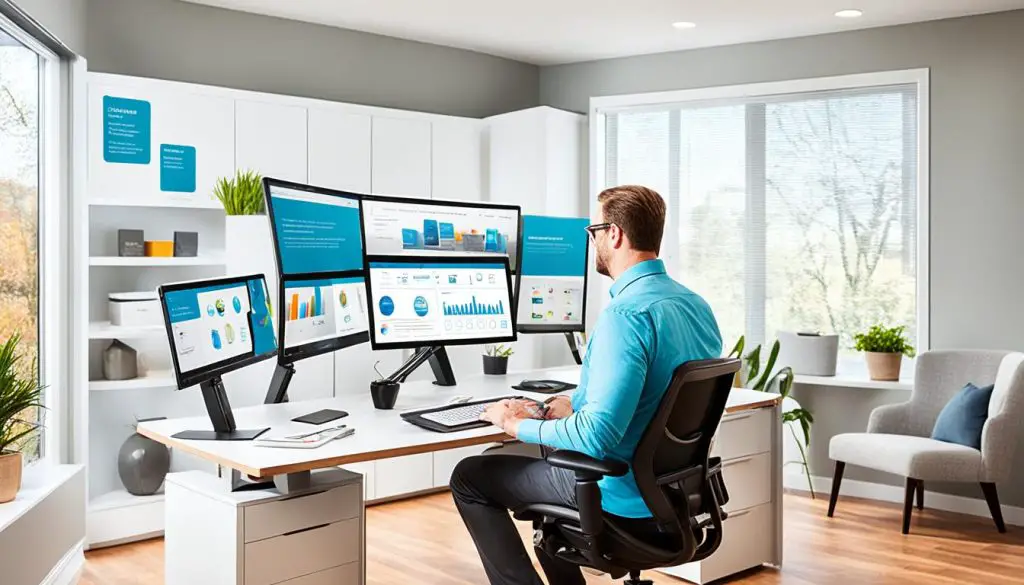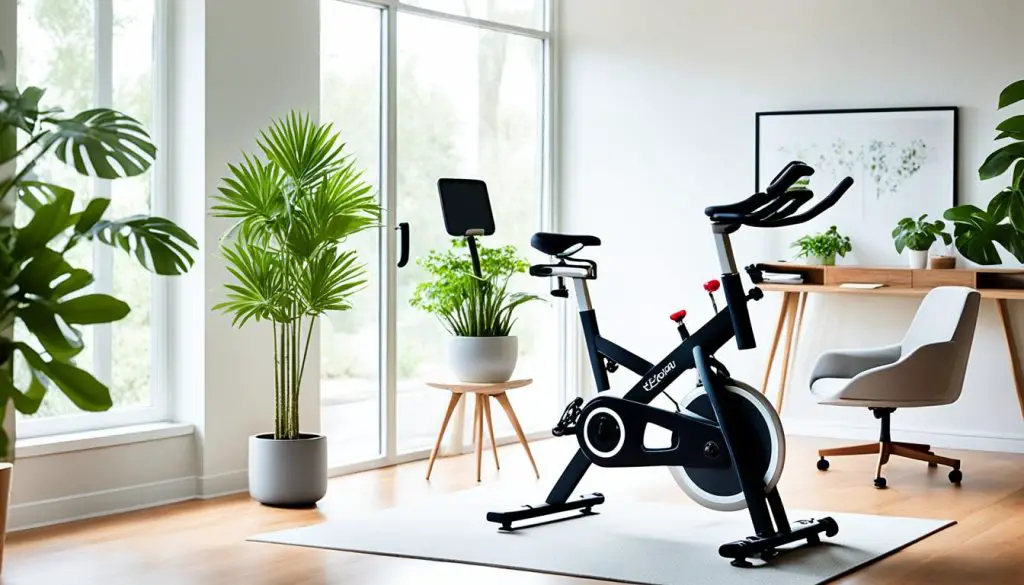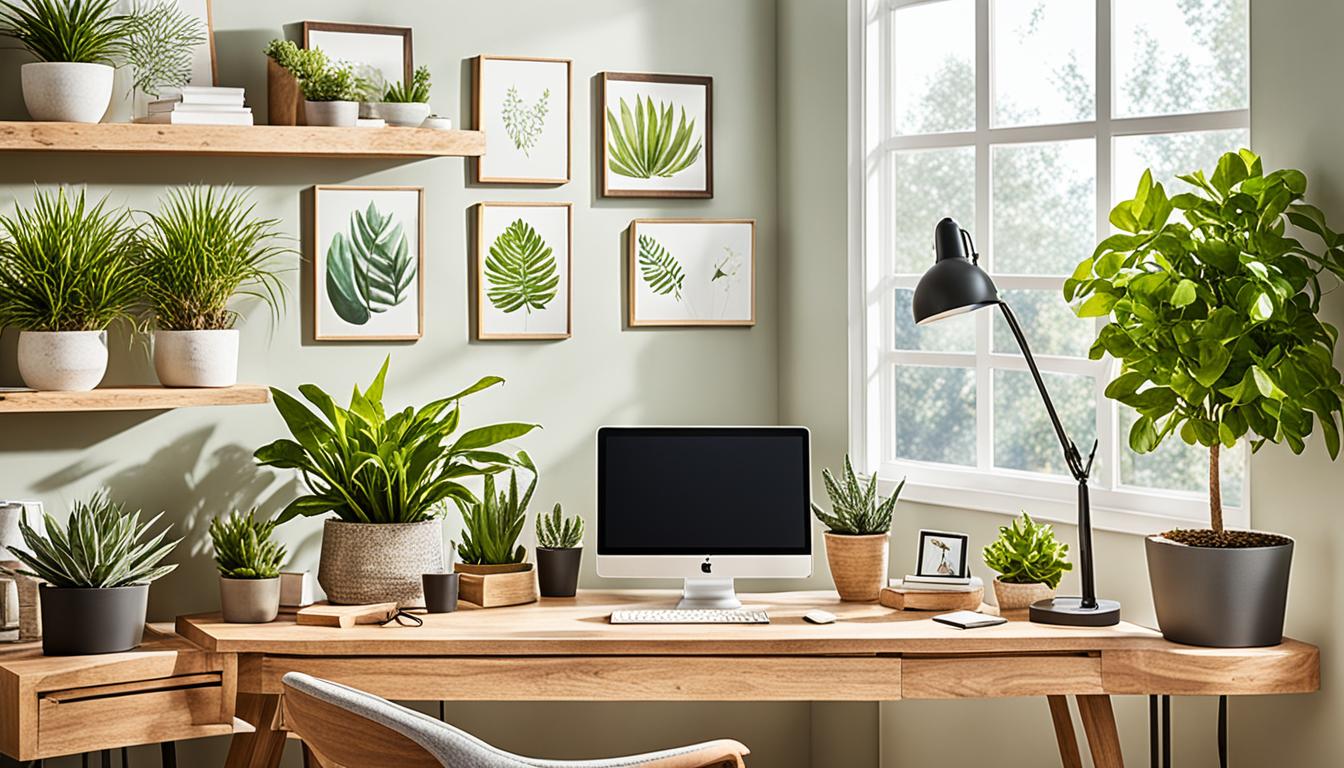Imagine managing your chronic illness from the comfort of home. I’ve experienced how a well-designed home office improves my wife’s life with endometriosis and fibromyalgia. The right design turns a home into a healing space for those with chronic conditions.
A chronic illness can change everything, from priorities to where you spend your time. Staying at home becomes vital for many with chronic illnesses, ensuring comfort and quality of life.1 Sadly, most homes are not ready for those with special needs. Creativity in design can make homes friendlier to those with disabilities affordably.1
A 12-year-old facing fibromyalgia tells a touching story in our second source. She saw her life change and struggled to enjoy what she loved. Her environment’s poor design amplified her health issues.2
Our third source highlights the crucial role of home design in aiding those with conditions like migraines and depression.2 So, how can a home office support and uplift those with chronic illnesses?
Introduction to Designing a Home Office for Chronic Illness
For folks with chronic conditions, home is more vital than ever. It helps them adapt to their new life.1 Their lifestyle, work, and relationships change. And their home becomes the central place for meeting their care needs.1Usually, homes don’t fit the needs of those with health issues. But, smart interior design can make a big difference.
Understanding the Challenges of Chronic Illness
Chronic illnesses like migraines and cancer truly impact life.2 They affect how we feel, think, and connect with others. There are many types, from arthritis to asthma.2
Living with these means changing how we live, eat, and think. It’s about staying positive and helping others like us too.2
Benefits of a Well-Designed Home Office
Good home design can boost our health and mood. Especially for those with chronic illnesses.3 It focuses on making spaces that feel good. This can really help people dealing with conditions such as migraines and chronic pain.3
A well-planned home office can do wonders for those with health challenges. It can help them work better and feel happier. By adding the right furniture and design, it becomes a healing space. This office helps strike a balance between work and self-care.
Inspiring Home Office Chronic Illness
For those with chronic illnesses, being at home is often the best choice. It helps with long-term care needs and keeps life comfortable and high-quality. Yet, many homes are not disability-friendly. But, with some clever interior design, these hurdles can be overcome without spending too much. This is crucial for the well-being of people living with chronic illnesses, says the third source.
The third source shows that designs promoting wellness and nature (biophilic designs) can help. They’re especially good for those dealing with migraines, chronic pain, and depression. Setting up a home office that fits the needs of those with chronic illnesses can bring about big changes. It can open doors to working from home, grab remote job chances, and manage their health better with the use of tech.
Focusing on the specific needs of those with chronic illnesses can turn a home office into a life-changing space. It can boost their well-being and help them do well both personally and professionally.4
Ergonomic Workspace Setup
Creating an ergonomic workspace is key for those with chronic illnesses. A 2022 study by Edwards Et. Al. found this setup cuts the risk of problems like carpal tunnel syndrome and lower back pain.5 This design approach boosts productivity, helps manage chronic pain, and improves overall health.
Adjustable Standing Desks
Using adjustable standing desks at home offers many pluses for those with health issues. Though it may cost more at first, it saves money in the long run. It boosts safety, productivity, and cuts down on sick days.5 These desks let you sit and stand, easing the harm from too much sitting. This is crucial for those with chronic pain or other health issues.
Ergonomic Chairs
Picking the right ergonomic chair matters a lot in a home office. A 1987 research by Helander et al. showed what makes a chair ergonomic, like the seat and back design.5 Choosing a chair with good back support, adjustable features, and comfort helps manage chronic pain and improves how you work.
Proper Lighting
Good lighting is critical, especially for those sensitive to bright light. Bright lights, loud sounds, and busy environments can make symptoms worse. Adding dimmable lights, daylight, and soft, ambient lights can help. It adjusts the workspace to meet personal needs and can lessen issues like migraines.
Organization and Accessibility
Building a clutter-free environment is vital for people dealing with ongoing health issues. It greatly boosts productivity and mental health. The second source mentions how staying indoors due to a bad environment negatively affected their health. But, they found joy in designing their space. They used design to look after themselves, choose creative elements, and make their room a healing place with their needed support.
Clutter-Free Environment
For a home office meant for those with ongoing health issues, a clutter-free setting is key. It should boost their mental health and productivity. The first source underlines going beyond basic rules like ADA. These might not fully help those with specific health issues.1 A person with Parkinson’s might need a special ramp due to walker use. The design’s aim should meet the person’s exact needs, not just follow general rules.
Accessible Storage Solutions
Accessible storage solutions also play a huge role in supporting people with health problems. It aids in their independence and managing their health.1 Changes for those with arthritis include well-placed counters and easy-to-reach tools. These changes make work easier and support productivity and mental health in the home office.
Biophilic Design Elements
Adding biophilic design elements like indoor plants and natural lighting can really help. It makes life easier for people with ongoing health issues.This method doesn’t just boost physical health. It can make a big difference for those fighting migraines, chronic pain, or feeling depressed. It helps their mental and emotional health too.
Indoor Plants
Studies prove that being around nature, even indoors, makes us happier. It lowers stress, increases our joy in life, and makes us feel better overall.6Having lots of indoor plants makes a space more peaceful and healing. This really helps people dealing with health issues.
Natural Lighting
Natural light is very good for us. It sharpens our thinking, boosts creativity, and helps us solve problems better.6If someone is ill for a long time, it’s important to manage the light in their home. This eases their sensitivity and makes their space more inviting.
Nature-Inspired Decor
Adding nature elements to décor doesn’t stop at just plants. Using natural colors and textures is also key to biophilic design.It helps everyone’s health who lives there, especially those with ongoing health issues. This kind of design soothes symptoms and supports healing.
Comfortable and Calming Atmosphere
Transforming your space into a soothing haven is key for those facing health challenges. Add7 cozy textures and use peaceful colors to change your working area into a sanctuary. This helps provide a much-needed break from overthinking your health issues.
Soothing Color Schemes
The author shared how they made their bedroom more comforting. They painted it in a soft pink, a color representing self-love and care.7 This act of personalizing their space boosted their confidence and creativity. It was a way to stay positive despite their health issues.
Cozy Textures and Fabrics
Another story talks about making a bedroom cozy with7 soft items. Adding soft blankets, pillows, and toys can physically comfort you. This and other design choices inspired them to hope and fight on, even with their ongoing health challenges.
Adaptive Technology and Assistive Devices
The right technology and equipment are key for people with chronic illnesses. They can make a big difference in how they live and feel every day. Many homes aren’t ready for this, though. They were designed with narrow spaces that are hard to navigate, especially with tools like walkers or wheelchairs.8 But, we can change that. Using voice-controlled smart home systems and adjustable computer gear helps in a big way. It makes their living space more accessible, gives them more independence, and boosts their productivity.
Voice-Controlled Smart Home Systems
For those who struggle to move or use their hands a lot, voice tech is a real help. With a simple command, these systems manage the lights, AC, and even lock the doors for you.9 This makes life easier and more independent for people with chronic illnesses.
Adjustable Computer Accessories
Many people need computers for work or everyday tasks. Adjusting computer tools like keyboards, mice, and monitors to your body can help a lot. It makes using the computer easier and more comfortable for people with health issues.9 This setup lets them work more comfortably and get things done better.

Mindfulness and Self-Care Spaces
Living with a chronic illness makes balance and well-being important. Having places for mindfulness and self-care at home helps. These spots support your physical, mental, and emotional health. The right design can really make a difference. It can improve how you manage your condition and your life overall.
Meditation Corner
Creating a quiet corner for meditation is soothing.2 It should have comfy seats, soft lights, and nature elements. This helps lower stress and aids in relaxation. This space offers a break from the difficulties of chronic illness. It helps in finding peace within yourself.
Reading Nook
Designing a special reading nook gives comfort to those with chronic illnesses.2 It includes soft furniture, natural light, and personal items. This creates a peaceful and calming space. It’s a perfect area for relaxing and taking care of your mind and heart. Reading a book or resting here can be very beneficial.
Maximizing Natural Light and Ventilation
Creating a space that helps people with chronic illnesses is crucial. Maximizing natural light and ventilation is key. A personal story in the second source shows how the wrong indoor lighting can harm health. By using blackout blinds and string lights, the person changed their space for the better.10
Natural light helps our body clocks and lifts our spirits. It also cuts down on the use of artificial lights indoors.10 Good ventilation keeps us comfortable, which is vital for those with health issues.10 Workplaces with great light and air see a boost in both employee happiness and work performance.11 Including these nature-related design features makes life easier for those with long-term health problems. It makes them feel closer to nature and lowers the impact of too much sound or light.10
Adding the right light and air flow to a workspace or home can greatly help those with ongoing health issues. It supports their physical health, mood, and mental health. This leads to a better ability to handle their health condition and live well.10
Personalized Decor and Inspiration
Living with a chronic illness, my home office has become a place of comfort.2 I’ve added motivational artwork and sentimental mementos to make it special. This space supports my health management and boosts my mental health.
Motivational Artwork
Motivational artwork has changed my perspective on living with a chronic illness.2 The bright colors and uplifting words remind me of my strength. They keep me positive and focused on my well-being during tough times.
Sentimental Mementos
My office also has sentimental mementos. These include photos and notes that mean a lot to me. They show the care and support I get from my loved ones. Having these around greatly helps my mental health and self-care.
Flexible and Multipurpose Spaces
Designing a home office for someone with a chronic illness is key. Spaces should be flexible and multipurpose. They must change as the person’s needs do.12 Most of our time is spent indoors, which is why it’s important to plan for both now and the future. This way, fewer changes will be needed later on.
If you add elements that are flexible and multipurpose, the office becomes more than just a place to work. It becomes a place for both work and self-care. This shifts the focus to managing chronic illness well while boosting work productivity and personal well-being.
The office should have everything from adjustable desks and comfy chairs to quiet reading corners. This mix addresses the individual’s special needs and likes. As their life and challenges change, the space can change with them. It is then a perfect spot for both work and taking care of themselves.
Incorporating Wellness and Self-Care Practices
People facing chronic illnesses find daily life tough. It’s vital for them to add wellness and self-care routines to each day.13 There are over 54 million Americans living with long-term health issues or disabilities.13 The U.S. Surgeon General urges them to lead healthier lives.13 By adding simple exercise tools and making spots for healthy snacks, life can get better.13
Exercise Equipment
Having exercise gear in your home office could change everything for those with ongoing health problems.13 Regular exercise can do a lot for how you feel, function, and enjoy life.13 Think about adding a small bike, some resistance bands, or a yoga mat. These simple tools can help keep you active and cope better with health challenges.13
Healthy Snack Station
A nook for nutritious snacks is a smart move for your home office.13 Eating well is as key as moving your body when it comes to wellness and self-care.13 By setting up a special spot for healthy snacks, you can grab something good all day long. This keeps your diet in check and your mind focused on wellness.13

Creating a Peaceful and Productive Ambiance
When dealing with a chronic illness, it’s key to have a calming place. This helps with your health and how you feel both physically and emotionally. Using things like noise-canceling gear and calming smells can make a huge difference in your space. It helps you deal better with your illness.
Noise-Canceling Measures
A person talked about how noisy and bright places bother them a lot. They couldn’t function well in such places. They used things like blackout blinds and soft lights to control what they heard and saw. This helped calm their senses and improved how they dealt with their illness.
Aromatherapy
Another person stressed that we must take care of our minds and hearts, not just our bodies. They suggested adding soothing items and scents around to make a pleasant space. This makes us feel better and happier while managing our health issues.2
Balancing Work and Rest
Living with a chronic illness makes it hard to balance work and rest. I’ve learned that having a space that fits my changing needs is key. This link has advice on making your home work for both productivity and self-care. Such spaces help me stay well despite health challenges.
Work can be hard, especially with a chronic illness. I’ve found that taking breaks is just as important as working hard. Having places at home where I can relax helps me stay focused and energized for work. This balance is key for those, like myself, dealing with health issues at work. For example, Astrid has trouble with her health while working in the aviation industry.14
My home is designed to be both productive and calming. I have spots for reading or meditating that help me balance my life.14 This design approach has made it easier for me to handle my health challenges and work well.
Source Links
- https://liveinplacedesigns.com/how-home-design-can-help-you-live-with-a-chronic-illness-or-condition/
- https://www.julieannrachelle.com/blended-decor-blog/wellness-design-for-chronic-illness
- https://biofilico.com/news/healthy-office-workplace-wellness-design-guide
- https://www.linkedin.com/pulse/remote-work-lifesaver-those-chronic-conditions-hennigan-she-her-
- https://capitolptdc.com/how-to-set-up-an-ergonomic-desk-to-prevent-workplace-injury
- https://europlan.nz/blog/designing-for-wellness-how-biophilic-elements-can-promote-health-in-the-workplace/
- https://www.boulderhomesource.com/wfh-office-design-guide/
- https://www.ncbi.nlm.nih.gov/pmc/articles/PMC6739607/
- https://www.medicalnewstoday.com/articles/assistive-devices-for-multiple-sclerosis
- https://heymache.com/blogs/the-wellness-onion-sustainable-lifestyle-design/explore-wellness-design-a-guide-to-creating-health-positive-hi-vibe-interiors
- https://www.yarooms.com/blog/sustainable-office-space-strategies-for-a-greener-workplace
- https://k2space.co.uk/knowledge/office-design-ideas
- https://www.ncbi.nlm.nih.gov/pmc/articles/PMC2901558/
- https://www.themuse.com/advice/working-living-with-a-chronic-illness
